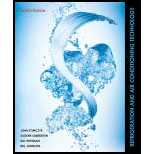
Refrigeration and Air Conditioning Technology (MindTap Course List)
8th Edition
ISBN: 9781305578296
Author: John Tomczyk, Eugene Silberstein, Bill Whitman, Bill Johnson
Publisher: Cengage Learning
expand_more
expand_more
format_list_bulleted
Concept explainers
Textbook Question
Chapter 50, Problem 12RQ
Free-cooling can be accomplished if the
A. enthalpy of the return air is lower than the enthalpy of the outside air.
B. enthalpy of the outside air is lower than the enthalpy of the return air.
C. enthalpy of the return air is lower than the enthalpy of the supply air.
D. enthalpy of the return air is the same as the enthalpy of the outside air.
Expert Solution & Answer
Trending nowThis is a popular solution!

Students have asked these similar questions
Correct answer is written below. Detailed and complete solution with fbd only. I will upvote, thank you. Expert solution pls
Correct answer is written below. Detailed and complete solution with fbd only. I will upvote, thank you.
Correct answer is written below. Detailed and complete solution with fbd only. I will upvote, thank you.
Chapter 50 Solutions
Refrigeration and Air Conditioning Technology (MindTap Course List)
Ch. 50 - Which of the following is true regarding the...Ch. 50 - Which process would best represent the opposite of...Ch. 50 - Mixed air is best described as the combination of...Ch. 50 - Which of the following should be taken into...Ch. 50 - A bonded roof is one that has A. reinforced steel...Ch. 50 - Properly installed roof curbs will reduce the...Ch. 50 - When rigging a unit to the roof, what minimum...Ch. 50 - What is the acceptable method for communicating...Ch. 50 - Prob. 9RQCh. 50 - Prob. 10RQ
Ch. 50 - The most efficient way to establish the best...Ch. 50 - Free-cooling can be accomplished if the
A....Ch. 50 - Prob. 13RQCh. 50 - Prob. 14RQCh. 50 - Explain why the outside air damper is typically...Ch. 50 - Briefly explain the purpose of ASHRAE Standard 62.Ch. 50 - Explain the concept of demand control ventilation.Ch. 50 - Explain how carbon dioxide levels can be used to...Ch. 50 - Describe the blowers used on VAV systems.Ch. 50 - A cooling-only VAV box has all of the following...Ch. 50 - Which of the following is true regarding a reheat...Ch. 50 - Variable refrigerant flow systems sense the...Ch. 50 - The acronym PID stands for ______, _____, and...Ch. 50 - Explain the main benefit of a heat-recovery VRF...Ch. 50 - The pump on a dry cooler can direct water to...Ch. 50 - During low ambient conditions, the space cooling...
Knowledge Booster
Learn more about
Need a deep-dive on the concept behind this application? Look no further. Learn more about this topic, mechanical-engineering and related others by exploring similar questions and additional content below.Similar questions
- Correct answer is written below. Detailed and complete solution only with fbd. I will upvote, thank you.arrow_forwardCorrect answer is written below. Detailed and complete solution only. I will upvote, thank you.arrow_forwardCorrect answer is written below. Detailed and complete solution with fbd only. I will upvote, thank you.arrow_forward
- Correct answer is written below. Detailed and complete solution only. I will upvote, thank you.arrow_forwardCorrect answer is written below. Detailed and complete solution with fbd only. I will upvote, thank you.arrow_forwardCorrect answer is written below. Detailed and complete solution only. I will upvote, thank you.arrow_forward
- Correct answer is written below. Detailed and complete solution only. I will upvote, thank you.arrow_forwardCorrect answer is written below. Detailed and complete solution only. I will upvote, thank you.arrow_forwardCorrect answer is written below. Detailed and complete solution with fbd only. I will upvote, thank you. Prefferably handwritten solution pleasearrow_forward
- Correct answer is written below. Detailed and complete solution with fbd only. I will upvote, thank you. Prefferably handwritten solution pleasearrow_forwardCorrect answer is written below. Detailed and complete solution only. I will upvote, thank you.arrow_forwardCorrect answer is written below. Detailed and complete solution with fbd only. I will upvote, thank you. Prefferably handwritten solution pleasearrow_forward
arrow_back_ios
SEE MORE QUESTIONS
arrow_forward_ios
Recommended textbooks for you
 Refrigeration and Air Conditioning Technology (Mi...Mechanical EngineeringISBN:9781305578296Author:John Tomczyk, Eugene Silberstein, Bill Whitman, Bill JohnsonPublisher:Cengage Learning
Refrigeration and Air Conditioning Technology (Mi...Mechanical EngineeringISBN:9781305578296Author:John Tomczyk, Eugene Silberstein, Bill Whitman, Bill JohnsonPublisher:Cengage Learning Welding: Principles and Applications (MindTap Cou...Mechanical EngineeringISBN:9781305494695Author:Larry JeffusPublisher:Cengage Learning
Welding: Principles and Applications (MindTap Cou...Mechanical EngineeringISBN:9781305494695Author:Larry JeffusPublisher:Cengage Learning

Refrigeration and Air Conditioning Technology (Mi...
Mechanical Engineering
ISBN:9781305578296
Author:John Tomczyk, Eugene Silberstein, Bill Whitman, Bill Johnson
Publisher:Cengage Learning

Welding: Principles and Applications (MindTap Cou...
Mechanical Engineering
ISBN:9781305494695
Author:Larry Jeffus
Publisher:Cengage Learning
Hydronics Step by Step; Author: Taco Comfort Solutions;https://www.youtube.com/watch?v=-XGNl9kppR8;License: Standard Youtube License